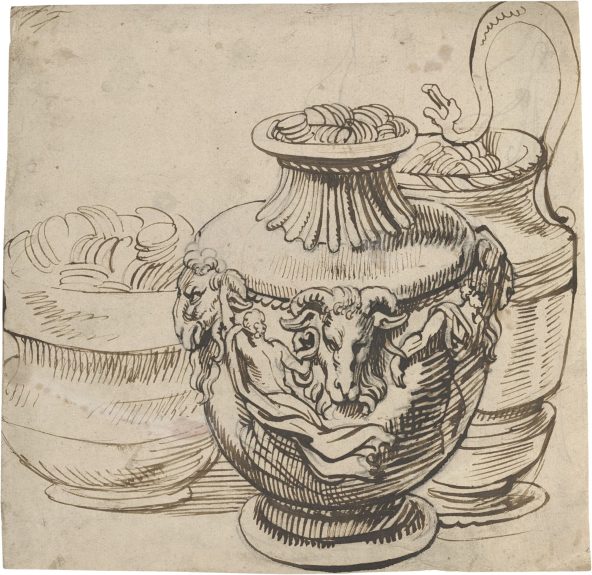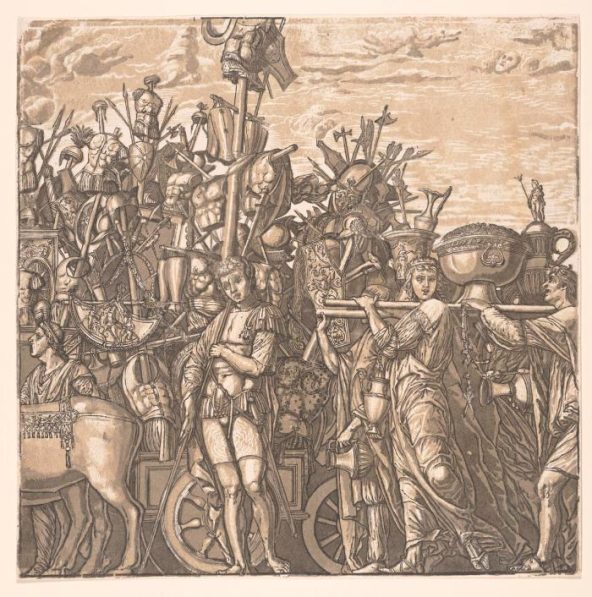Article: Ancient Spoils of War
Focus on the Peck Feature
In ancient Greece and Rome, it was customary for conquering armies to seize objects of value from defeated foes. This Focus on the Peck Collection installation presents two works of art that feature depictions of ancient Roman spoils of war. The first is a drawing attributed to seventeenth-century Flemish artist Anthony van Dyck that depicts three vessels filled with gold coins. The second is a chiaroscuro woodcut by sixteenth-century Italian artist Andrea Andreani that illustrates a Roman triumphal procession featuring similar looted items. Violently acquired, war “booty” represented both wealth and prestige to those who plundered it.
In ancient Greece and Rome, it was customary for a conquering army to seize objects of value from defeated foes. Items ranged from arms and armor, currency, and expensive commodities to exotic animals, livestock, and even people. Before it was distributed by the commanding general to soldiers and supporters, war “booty” was configured into temporary monuments on the battlefield and exhibited to enthusiastic onlookers during triumphal processions through the city. Violently acquired, such items represented both wealth and prestige to those who plundered them.
This Focus on the Peck Collection installation presents two works of art, a drawing and a woodcut, that feature depictions of ancient Roman spoils of war. The drawing attributed to seventeenth-century Flemish artist Anthony van Dyck illustrates three vessels filled to the brim with coins and is likely a study for a more detailed and extensive composition. Sixteenth-century Italian artist Andrea Andreani’s chiaroscuro woodcut shows a segment of a triumphal procession led by Roman military general Julius Caesar, originally depicted by Italian Renaissance artist Andrea Mantegna around 1484 to 1492. It provides a visual context for how the vases in Van Dyck’s drawing would have been incorporated in a stately victory parade.
Three Vases

Attributed to Anthony van Dyck, Flemish, 1599 – 1641, Three Vases, c. 1618, pen and brown ink with black chalk. The Peck Collection, 2017.1.122
See Three Vases in more detail here.
Plundered gold coins fill three assorted vessels in this drawing attributed to Flemish artist Anthony van Dyck. The most elaborately drawn vase features three goat heads interlaced with dancers, a reference to the Roman deity Bacchus, god of agriculture and wine.
The drawing relates to a painting called Trophy, now in the Liechtenstein Collection, Vienna, executed by Flemish artist Peter Paul Rubens’s assistants. It depicts a tropaeum, or monument, constructed of captured weapons, armor, and battle standards with three vases situated in the immediate foreground. Created around 1616 or 1617, the painting was among the preparatory designs made for Rubens’s large tapestry cycle about Decius Mus, a Roman Consul who sacrificed himself to gain victory for his people. As Van Dyck worked with Rubens early in his career, the Peck Collection drawing may be a preliminary design for the finished painting.
The Triumph of Julius Caesar: The Little Bearers

Andrea Andreani, Italian, 1558/1559 – 1629 (printmaker) and Andrea Mantegna, Italian, c. 1431 – 1506 (designer), The Triumph of Julius Caesar: The Little Bearers, c. 1599, chiaroscuro woodcut. Burton Emmett Collection, 58.1.186
See The Triumph of Julius Caesar: The Little Bearers in more detail here.
Accomplished printmaker Andrea Andreani translated paintings and sculpture by Italian Renaissance artists into chiaroscuro woodcuts — printed images made from multiple woodblocks inked with different tones. This print reproduces a scene from Andrea Mantegna’s acclaimed series of nine paintings depicting The Triumph of Julius Caesar, created a century earlier for the Gonzaga Ducal Palace in Mantua. In this scene, young men carry various spoils of war, including finely wrought arms and armor, vases and pitchers, as well as an urn overflowing with coins. Andreani’s series was enormously popular, both for its ambitious scale and for its references to classical antiquity.
